The Course of the Corset: An Elizabethan Revival
ELIZABETHAN CORSETS
The corset has been around since antiquity. Last week I introduced you to the ancient Minoans who used the corset as an outer garment to hold up their exposed breasts and give them a tiny waist. The Minoan's use of a corset differed from their Grecian counterparts who did not want to enhance a woman's body but hide it. After the fall of the Minoan culture the corset drifted into obscurity and didn't reappear until the Elizabethan Era (1558-1603AD).
Fashion is timeless yet always changing. Ideas about what the perfect body should look like change over time and women strive to conform their body to whatever society demands upon them. During the 16th century, the most desired shape of the female form was a cylinder torso with flatten and raised bust line. There was little to no interest on the waistline. The corset went through many changes during the reign of Queen Elizabeth I. A corset, no matter how different they were, was always made of two pieces of fabric called bodies. The bodies were sewn together leaving two ends. It was made to fit around the woman's body then she could fasten the ends together using lace or hooks. Much of what we know about Elizabethan corsets are derived from artwork and from the exhumation of burials from that time period.
EARLY ELIZABETHAN
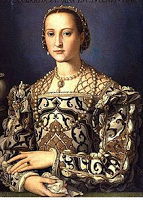 Eleanor of Toledo (1539-1562)
Eleanor of Toledo (1539-1562)
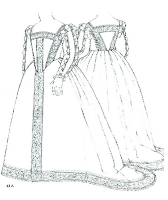 Eleanor of Toledo's burial gownEarly Elizabethan corsets were made from two layers of linen that were held together with a stiff paste. They weren't so much of corsets as they were stiffened bodices. Stiffened linens held together by lace in the front or back were first worn as undergarments in the fourteenth century. The fashion continued until the middle of the 16th century. An example of this type of undergarment was found on the body of Eleanor of Toledo, who had died of a combination of pulmonary tuberculosis and malaria. She was buried in 1562. Eleanor was a Spanish noble woman who served as duchess consort of Florence. Between the ages of 18 to 32 she had given birth to eleven children. She is considered to be one of the first modern first lady. Eleanor and her family's bodies was exhumed in 2004 by a team of anthropologists for scientific exploration to solve many mysteries surrounding the Medici family. The Medici Project revealed many secrets including that Eleanor was five feet tall, had a form of rickets in her youth, suffered from a calcium deficiency, had twisted legs, suffered from toothaches and shin splines caused by inflammation that generally occurred from the later stages of syphilis. At the time of her death she had a severe dental disease and arthritis. She was known to spend a lot of gold on her clothing, which she most likely used to hide her physical ailments. When her body was exhumed her skeleton was covered in two pieces of clothing, her burial gown and stiffened bodice.
Eleanor of Toledo's burial gownEarly Elizabethan corsets were made from two layers of linen that were held together with a stiff paste. They weren't so much of corsets as they were stiffened bodices. Stiffened linens held together by lace in the front or back were first worn as undergarments in the fourteenth century. The fashion continued until the middle of the 16th century. An example of this type of undergarment was found on the body of Eleanor of Toledo, who had died of a combination of pulmonary tuberculosis and malaria. She was buried in 1562. Eleanor was a Spanish noble woman who served as duchess consort of Florence. Between the ages of 18 to 32 she had given birth to eleven children. She is considered to be one of the first modern first lady. Eleanor and her family's bodies was exhumed in 2004 by a team of anthropologists for scientific exploration to solve many mysteries surrounding the Medici family. The Medici Project revealed many secrets including that Eleanor was five feet tall, had a form of rickets in her youth, suffered from a calcium deficiency, had twisted legs, suffered from toothaches and shin splines caused by inflammation that generally occurred from the later stages of syphilis. At the time of her death she had a severe dental disease and arthritis. She was known to spend a lot of gold on her clothing, which she most likely used to hide her physical ailments. When her body was exhumed her skeleton was covered in two pieces of clothing, her burial gown and stiffened bodice. 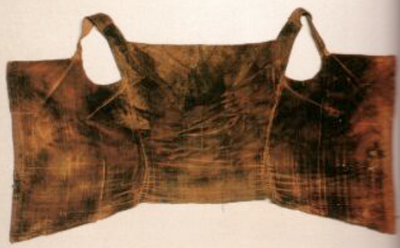 Eleanor of Toledo's stiffed bodice worn underneath her gownEleanor's stiffened bodice was made of red silk velvet and was lined with one to two layers of strong linens. It had no boning in it. The garment was close fitting and lacked sleeves. It was fastened up the center front using hooks and eyes. Small gores set on the sides seams allowed the garment to fit over Eleanor's hips and waist. Eleanor's stiffed bodice is housed at the Palazzo Piti in Florence, Italy.
Eleanor of Toledo's stiffed bodice worn underneath her gownEleanor's stiffened bodice was made of red silk velvet and was lined with one to two layers of strong linens. It had no boning in it. The garment was close fitting and lacked sleeves. It was fastened up the center front using hooks and eyes. Small gores set on the sides seams allowed the garment to fit over Eleanor's hips and waist. Eleanor's stiffed bodice is housed at the Palazzo Piti in Florence, Italy.
LATE ELIZABETHAN
The Pfaltzgräfin Corset
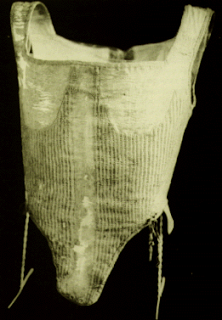 The Pfaltzgräfin CorsetThe second oldest example of Elizabethan Era period corsets comes from Germany. Although, like Eleanor's corset it does not come directly from England, it still gives us a good example of what women of that time period were wearing underneath their clothing. The corset dates to 1598 and was found on the body of Pfaltzgräfin Dorothea Sabina von Neuburg. Known as the Munich bodies, the corset was made from three layers of ivory "lightweight, very fine corded silk" The front layer of silk was backed with linen. Inside the corset were two more layers of linen that contained boning channels. Whale bones would have been inserted between the layers of fabric to give added support. The corset features shoulder straps. Unlike Eleanor of Toledo's corset, whalebone corsets were more confining and required a woman to wear extra undergarments to further exaggerate her figure. The boning configuration of this corset was unique in that it the boning met underneath the breasts, much like the wire of a modern wire bra does today. Doing so allowed for a better fit and a smoother line down the torso. The cups of the breasts were left unboned. Between the breasts was a busk pocket. Here the woman would insert a piece of ivory, bone or wood (called a busk) then tie it into place with a ribbon so it wouldn't shift. The busk would separate the breasts. Eventually when the woman had married she would give the lace to her husband as a symbol of their intimacy. The Pfaltzgräfin corset is housed in Bayerisches National Museum. Sadly the boning, busk and lining have not survived through the centuries.
The Pfaltzgräfin CorsetThe second oldest example of Elizabethan Era period corsets comes from Germany. Although, like Eleanor's corset it does not come directly from England, it still gives us a good example of what women of that time period were wearing underneath their clothing. The corset dates to 1598 and was found on the body of Pfaltzgräfin Dorothea Sabina von Neuburg. Known as the Munich bodies, the corset was made from three layers of ivory "lightweight, very fine corded silk" The front layer of silk was backed with linen. Inside the corset were two more layers of linen that contained boning channels. Whale bones would have been inserted between the layers of fabric to give added support. The corset features shoulder straps. Unlike Eleanor of Toledo's corset, whalebone corsets were more confining and required a woman to wear extra undergarments to further exaggerate her figure. The boning configuration of this corset was unique in that it the boning met underneath the breasts, much like the wire of a modern wire bra does today. Doing so allowed for a better fit and a smoother line down the torso. The cups of the breasts were left unboned. Between the breasts was a busk pocket. Here the woman would insert a piece of ivory, bone or wood (called a busk) then tie it into place with a ribbon so it wouldn't shift. The busk would separate the breasts. Eventually when the woman had married she would give the lace to her husband as a symbol of their intimacy. The Pfaltzgräfin corset is housed in Bayerisches National Museum. Sadly the boning, busk and lining have not survived through the centuries. The Effigy Corset
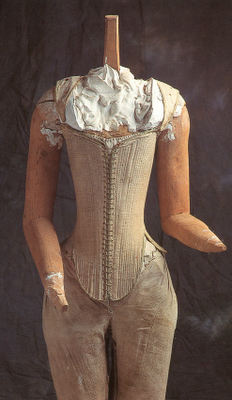 The Effigy Corset at Westminster AbbeyBack in England, the fashion of Queen Elizabeth expected the women of her courtly classes to wear a long stiff corset that reached from the bust to below the natural waistline. Today we are fortunate enough to have an example of an Elizabethan courtly corset in the Effigy Corset. Westminster Abbey has been home to items that has belonged to English monarch for generations. In 1995, the officials of Westminster Abbey had pulled out an effigy that contained clothes they had been mistakenly dated to 1760. The clothes were in need of repair and cleaning. Renowned costume researcher Janet Arnold was given permission to examine the panniers and corset that was on the effigy. The opportunity to examine this never worn corset was a chance of a lifetime. Most corset that were worn by humans stank from sweat or had evidence of the years of wear and tear. After a through examination of both the panniers and the corset, Arnold concluded the panniers were of the 18th century but the corset had been much older. She dated the corset to 1603, which is towards the end of Queen Elizabeth's reign. The design of the corset could easily fool anyone who is not familiar with period costumes to believe it had originated from the 18th century. Corset of both time periods are very similar in design. The corset is shaped and fully boned like an 18th century corset but it is the pattern of boning that sets it apart as being Elizabethan. Corsets of the 18th century had boning that changed direction from front to back in order to create the distinguished V shape in the middle of the woman's body. Whereas the boning in Elizabethan corsets always run parallel from front to back never changing direction. A noticeable and major difference between the two corsets lies in the rear closer. Elizabethan corsets did not have rear closures whereas 18th century corsets, even if they had lacing in the front, always were tied in the back. The front closure of the 18th century corset held the stomacher in place. Janet Arnold concluded that the corset could have belonged to Queen Elizabeth I. If so then, she concluded, the dimensions of the corset could represent the exact bodily dimensions of the queen just before her death. The Effigy Corset is housed at Westminster Abbey. You can find Janet Arnold's detailed report at the Westminster Library.
The Effigy Corset at Westminster AbbeyBack in England, the fashion of Queen Elizabeth expected the women of her courtly classes to wear a long stiff corset that reached from the bust to below the natural waistline. Today we are fortunate enough to have an example of an Elizabethan courtly corset in the Effigy Corset. Westminster Abbey has been home to items that has belonged to English monarch for generations. In 1995, the officials of Westminster Abbey had pulled out an effigy that contained clothes they had been mistakenly dated to 1760. The clothes were in need of repair and cleaning. Renowned costume researcher Janet Arnold was given permission to examine the panniers and corset that was on the effigy. The opportunity to examine this never worn corset was a chance of a lifetime. Most corset that were worn by humans stank from sweat or had evidence of the years of wear and tear. After a through examination of both the panniers and the corset, Arnold concluded the panniers were of the 18th century but the corset had been much older. She dated the corset to 1603, which is towards the end of Queen Elizabeth's reign. The design of the corset could easily fool anyone who is not familiar with period costumes to believe it had originated from the 18th century. Corset of both time periods are very similar in design. The corset is shaped and fully boned like an 18th century corset but it is the pattern of boning that sets it apart as being Elizabethan. Corsets of the 18th century had boning that changed direction from front to back in order to create the distinguished V shape in the middle of the woman's body. Whereas the boning in Elizabethan corsets always run parallel from front to back never changing direction. A noticeable and major difference between the two corsets lies in the rear closer. Elizabethan corsets did not have rear closures whereas 18th century corsets, even if they had lacing in the front, always were tied in the back. The front closure of the 18th century corset held the stomacher in place. Janet Arnold concluded that the corset could have belonged to Queen Elizabeth I. If so then, she concluded, the dimensions of the corset could represent the exact bodily dimensions of the queen just before her death. The Effigy Corset is housed at Westminster Abbey. You can find Janet Arnold's detailed report at the Westminster Library.Join me tomorrow as we pay special tribute the Jewish patriot, Hyman Soloman, and learn how without his support the United States wouldn't exist.
What is your favorite outfit to wear?
Published on July 03, 2012 04:17
No comments have been added yet.



